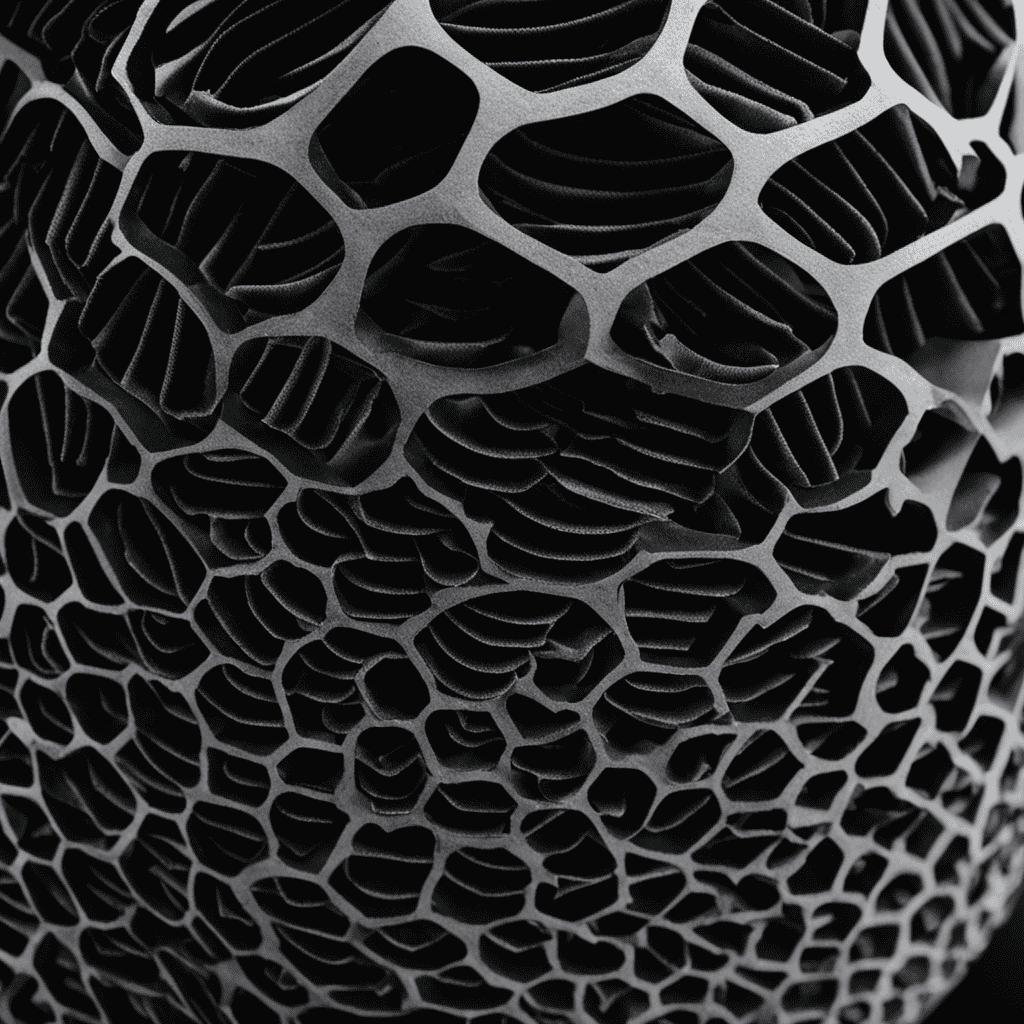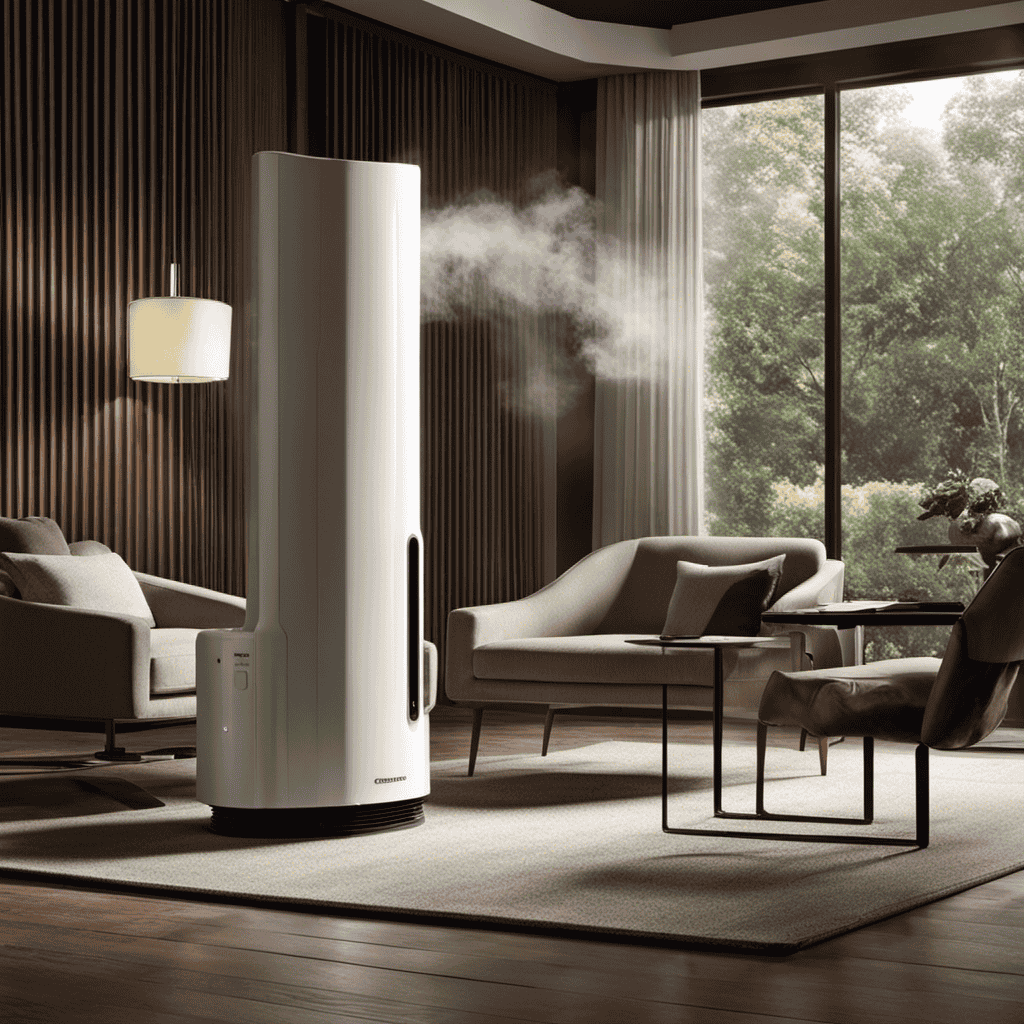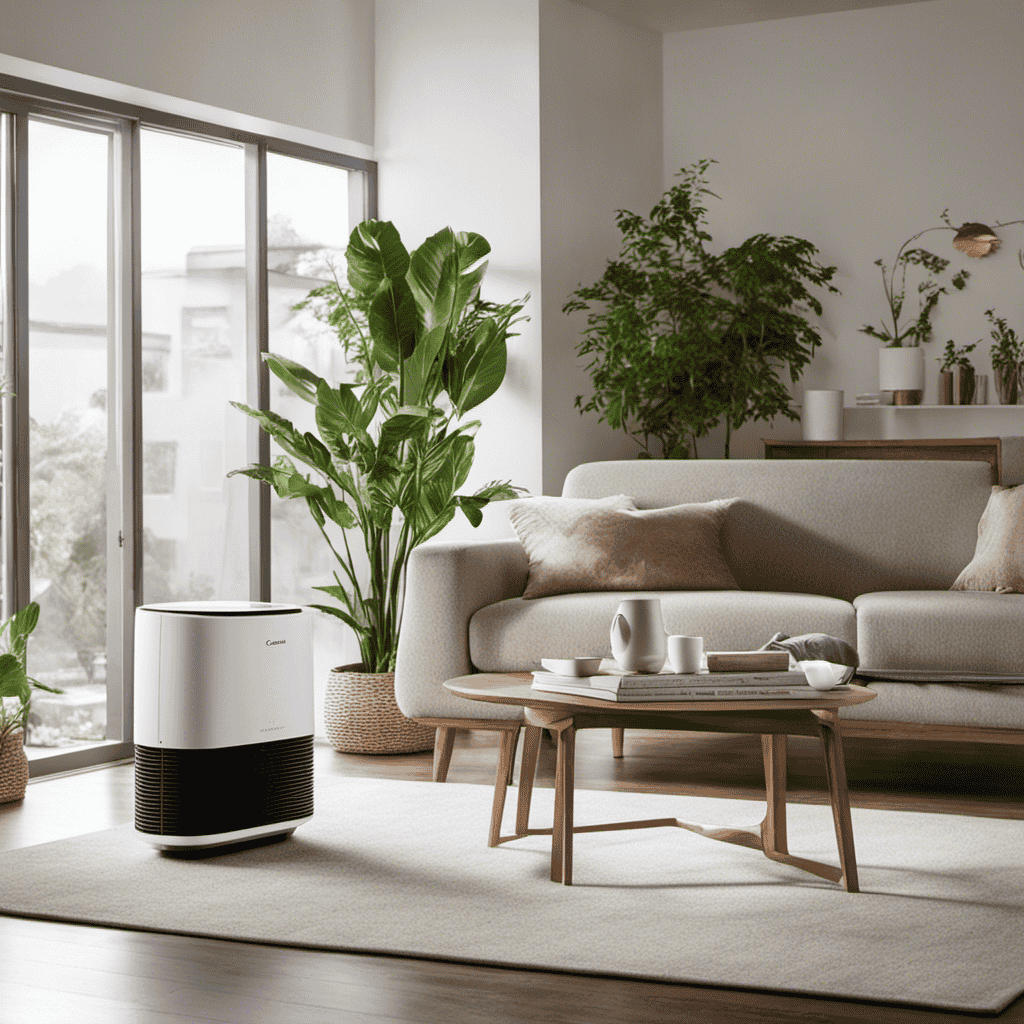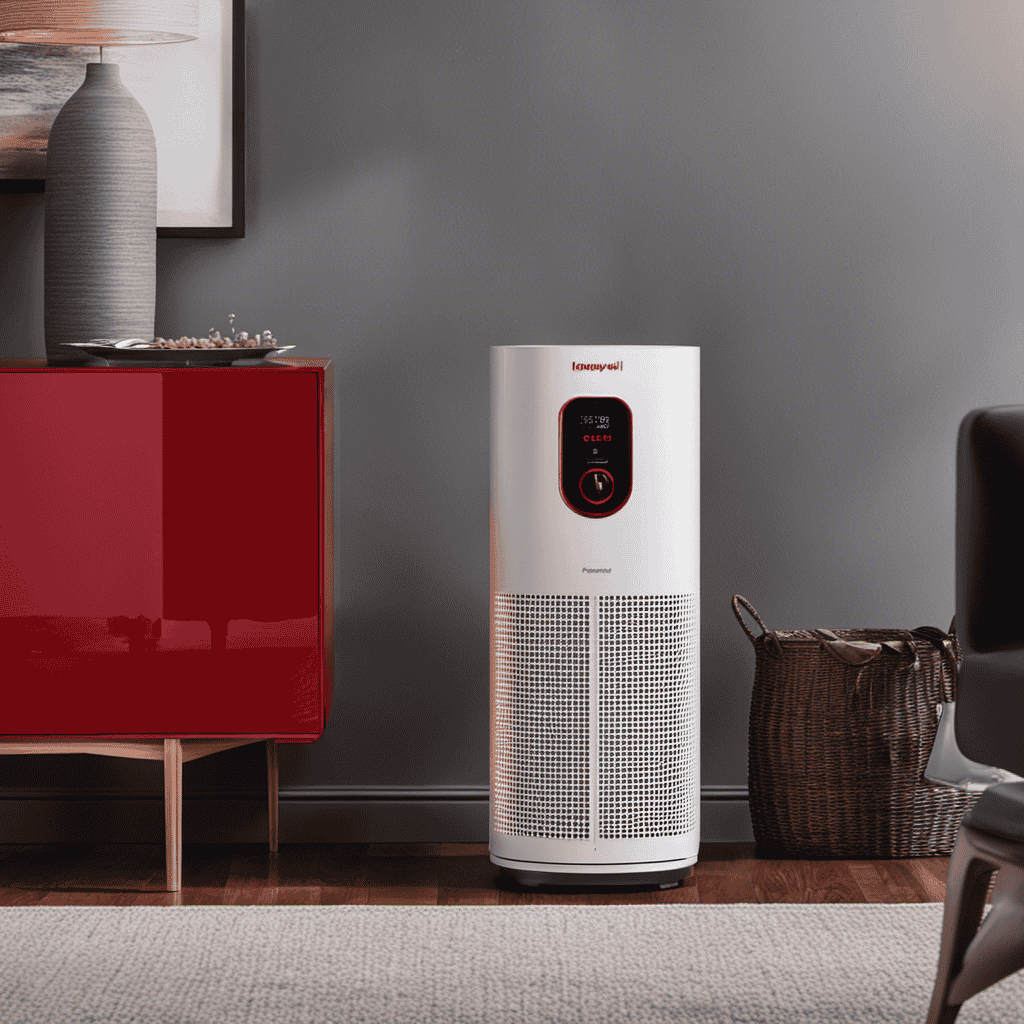As a specialist in air purification, I have frequently compared charcoal to the overlooked hero of fresh air.
In this article, I will delve into the science behind charcoal’s role in air purification and guide you on determining the optimal amount needed for your air purifier.
By understanding the factors influencing charcoal quantity, recommended amounts for different room sizes, and the importance of regular replacement, you’ll be equipped to create a healthier and fresher living environment.
So, let’s dive into the world of charcoal and unlock its purifying potential!
Key Takeaways
- Charcoal has a highly porous structure and absorbs a wide range of pollutants.
- Charcoal works best when combined with other filtration methods.
- Regular replacement of charcoal filters is crucial for maintaining effectiveness.
- The amount of charcoal needed depends on the room size and air pollution level.
Understanding the Role of Charcoal in Air Purification
Charcoal plays a crucial role in air purification by trapping and removing impurities. Understanding the benefits of charcoal in air purification is essential for selecting the right air purifier.
Firstly, charcoal, also known as activated carbon, has a highly porous structure that allows it to absorb a wide range of pollutants such as volatile organic compounds, odors, and chemicals. This makes it an effective tool for improving indoor air quality.
However, there are common misconceptions about charcoal in air purifiers. Some people believe that charcoal alone can completely purify the air, but it is important to note that it works best when combined with other filtration methods, such as HEPA filters.
Additionally, it is crucial to regularly replace the charcoal filters to maintain their effectiveness in trapping impurities. Understanding these benefits and misconceptions will help in making informed decisions when it comes to air purifiers.
Factors to Consider When Determining Charcoal Quantity for an Air Purifier
To determine the quantity you should use for your air purifier, consider various factors such as the size of your room and the level of air pollution. These factors play a crucial role in determining the effectiveness of your air purifier and ensuring that it can efficiently filter out pollutants from the air.
When deciding on the charcoal quantity, keep in mind the following factors to consider:
- Room size: A larger room will require a higher quantity of charcoal to ensure thorough air purification.
- Air pollution level: If you live in an area with high levels of air pollution, you may need to increase the charcoal quantity to effectively remove pollutants.
- Duration of usage: If you plan to run your air purifier for extended periods, it is advisable to have a sufficient amount of charcoal to maintain its efficiency over time.
Considering these factors will help you determine the right charcoal quantity for your air purifier and ensure cleaner and healthier air in your home.
Recommended Charcoal Amounts for Different Room Sizes
When considering the recommended charcoal amounts for different room sizes, it’s important to take into account the specific needs of each space.
In small rooms, a smaller amount of charcoal may be sufficient to effectively purify the air, while medium-sized rooms may require a slightly larger quantity.
For larger rooms, a higher amount of charcoal is typically recommended to ensure optimal air purification and filtration.
Small Room Charcoal
You’ll need a small amount of charcoal for purifying the air in a small room. Charcoal is a highly effective natural air purifier, capable of removing pollutants and odors from the surrounding environment. When choosing the right amount of charcoal for your small room, consider the room size and air quality.
Here are three key factors to consider:
-
Room size: A small room typically requires a smaller amount of charcoal compared to larger spaces. The size of the room will determine the amount of charcoal needed to effectively filter the air.
-
Air quality: If the air quality in your small room is particularly poor, you may need to increase the amount of charcoal used. This will help in removing a higher concentration of pollutants and improving overall air quality.
-
Duration: The duration for which you plan to use the air purifier also plays a role in determining the amount of charcoal needed. If you plan to use it continuously, you may need to replenish the charcoal more frequently to maintain optimal air purification.
Medium Room Charcoal
Consider using a medium amount of charcoal for purifying the air in a medium-sized room. It will effectively remove pollutants and odors from the environment. When it comes to medium room air quality, charcoal can play a significant role in improving the overall freshness and cleanliness of the air.
The usage patterns for charcoal in a medium room may vary depending on the specific needs and circumstances. Generally, it is recommended to place charcoal briquettes or activated charcoal in a container or pouch and distribute them strategically around the room. This allows for maximum air circulation and contact with the charcoal, enhancing its purifying capabilities.
It’s important to monitor the condition of the charcoal regularly and replace it when it becomes saturated or loses its effectiveness. With proper usage and maintenance, charcoal can be a valuable tool for improving air quality in medium-sized rooms.
Large Room Charcoal?
In a large room, it’s essential to use an adequate amount of charcoal to effectively eliminate pollutants and odors from the environment. Large room air filters equipped with charcoal can greatly improve the air quality, providing a healthier living space.
When considering the benefits of using charcoal in air purifiers, there are several emotional responses that can be evoked:
-
Relief: Knowing that the air in your home is being purified, reducing harmful pollutants and allergens.
-
Comfort: Breathing in clean, fresh air can create a sense of relaxation and wellbeing.
-
Confidence: Having a reliable charcoal air purifier gives you peace of mind, knowing that you are taking proactive steps to protect your health.
To ensure optimal performance, it’s crucial to regularly replace the charcoal in air purifiers. By doing so, you can maintain the effectiveness of the filtration system and continue to enjoy clean and purified air.
The Importance of Regularly Replacing Charcoal in Air Purifiers
When using an air purifier, it’s crucial to regularly replace the charcoal for optimal performance. The importance of regular maintenance cannot be overstated.
Activated charcoal is a key component of air purifiers, as it has remarkable adsorption properties that help remove pollutants and odors from the air. Over time, the charcoal becomes saturated with impurities, reducing its effectiveness.
By regularly replacing the charcoal, you ensure that your air purifier continues to provide clean and fresh air. Not only does this improve the air quality in your home or office, but it also helps maintain the performance of the air purifier itself.
The benefits of using activated charcoal are numerous, including the ability to trap and remove harmful chemicals, allergens, and volatile organic compounds. So, make sure to prioritize the regular replacement of charcoal in your air purifier for optimal results.
How to Calculate Charcoal Usage Based on Air Quality and Usage Patterns
To accurately calculate your charcoal usage, you should closely monitor the air quality and your usage patterns. By doing so, you can determine the effectiveness of the charcoal in your air purifier and optimize your usage accordingly. Here are some key points to consider:
-
Health Benefits: Understanding the amount of charcoal needed can help ensure that you are breathing clean air and minimizing exposure to harmful pollutants.
-
Cost Efficiency: By calculating your charcoal usage, you can avoid unnecessary expenses by only replacing the charcoal when it is truly necessary.
-
Environmental Impact: Optimizing your charcoal usage can help reduce waste and minimize the carbon footprint associated with manufacturing and disposing of charcoal.
Tips for Maximizing the Efficiency of Charcoal in Air Purifiers
By regularly monitoring air quality and usage patterns, you can maximize the efficiency of charcoal in your air purifiers. Properly managing and maintaining your air purifier can significantly extend the lifespan of the charcoal and enhance its performance. Here are some tips to help you get the most out of your charcoal filters:
| Tips to Maximize Charcoal Efficiency |
|---|
| Regularly monitor air quality and usage patterns |
| Replace charcoal filters as recommended by the manufacturer |
| Clean or replace pre-filters to prevent clogging |
| Store unused charcoal filters in airtight containers to prevent absorption of contaminants |
Following these tips will not only improve the performance of your air purifier, but also maximize the lifespan of the charcoal filters. By optimizing the efficiency of charcoal, you can ensure that your air purifier continues to effectively remove pollutants from your indoor environment.
Common Mistakes to Avoid When Using Charcoal in Air Purifiers
One common mistake to avoid is not regularly monitoring air quality and usage patterns. Properly using charcoal in air purifiers requires attention to detail and avoiding common misconceptions. Here are some important points to consider:
-
Incorrect storage: Storing charcoal in a damp or humid environment can reduce its effectiveness. It is crucial to store charcoal in a dry and sealed container to maintain its absorbent properties.
-
Not replacing charcoal: Over time, charcoal loses its ability to absorb impurities. Failing to replace it regularly can result in reduced air purification efficiency.
-
Using the wrong amount: Using too much or too little charcoal can impact the air purifier’s performance. It is essential to follow the manufacturer’s guidelines for the recommended amount of charcoal to achieve optimal results.
Frequently Asked Questions
Can I Use Any Type of Charcoal in an Air Purifier, or Are There Specific Types That Are Recommended?
There are specific types of air purifiers that use charcoal, and it is recommended to use the appropriate type. Using charcoal in an air purifier has its pros and cons, which should be considered.
How Often Should I Replace the Charcoal in My Air Purifier?
How long does charcoal last in an air purifier, and when should it be replaced? Using too much charcoal in an air purifier could negatively affect air quality. It’s important to know the proper replacement interval for optimal performance.
Can I Reuse the Charcoal From My Air Purifier, or Do I Need to Replace It Completely?
I can reuse the charcoal from my air purifier, but its effectiveness will decrease over time. Eventually, it will need to be replaced completely to ensure optimal air purification.
Is There a Specific Brand or Quality of Charcoal That Is More Effective for Air Purification?
When it comes to the effectiveness of charcoal for air purification, different brands vary in their ability to trap and remove pollutants. Factors such as pore size, surface area, and impurity levels can impact performance.
Are There Any Potential Health Risks or Side Effects Associated With Using Charcoal in an Air Purifier?
There are potential health risks associated with using charcoal in an air purifier, such as inhalation of fine particles and possible irritation to the respiratory system. However, the benefits of charcoal in purifying air outweigh these risks when used correctly.
Conclusion
In conclusion, understanding the role of charcoal in air purification is essential for maintaining a healthy indoor environment. By considering factors such as room size and air quality, you can determine the appropriate amount of charcoal needed for your air purifier.
Regularly replacing the charcoal is crucial to ensure its effectiveness. Remember, maximizing the efficiency of charcoal in air purifiers requires careful consideration and avoidance of common mistakes.
So, let’s embark on this charcoal-powered journey towards cleaner and fresher air!










